The Samsung SSD 830 Review
by Anand Lal Shimpi on September 24, 2011 1:02 AM EST- Posted in
- SSDs
- Storage
- Samsung
- pm830
- Samsung SSD 830
AnandTech Storage Bench 2011
Last year we introduced our AnandTech Storage Bench, a suite of benchmarks that took traces of real OS/application usage and played them back in a repeatable manner. I assembled the traces myself out of frustration with the majority of what we have today in terms of SSD benchmarks.
Although the AnandTech Storage Bench tests did a good job of characterizing SSD performance, they weren't stressful enough. All of the tests performed less than 10GB of reads/writes and typically involved only 4GB of writes specifically. That's not even enough exceed the spare area on most SSDs. Most canned SSD benchmarks don't even come close to writing a single gigabyte of data, but that doesn't mean that simply writing 4GB is acceptable.
Originally I kept the benchmarks short enough that they wouldn't be a burden to run (~30 minutes) but long enough that they were representative of what a power user might do with their system.
Not too long ago I tweeted that I had created what I referred to as the Mother of All SSD Benchmarks (MOASB). Rather than only writing 4GB of data to the drive, this benchmark writes 106.32GB. It's the load you'd put on a drive after nearly two weeks of constant usage. And it takes a *long* time to run.
1) The MOASB, officially called AnandTech Storage Bench 2011 - Heavy Workload, mainly focuses on the times when your I/O activity is the highest. There is a lot of downloading and application installing that happens during the course of this test. My thinking was that it's during application installs, file copies, downloading and multitasking with all of this that you can really notice performance differences between drives.
2) I tried to cover as many bases as possible with the software I incorporated into this test. There's a lot of photo editing in Photoshop, HTML editing in Dreamweaver, web browsing, game playing/level loading (Starcraft II & WoW are both a part of the test) as well as general use stuff (application installing, virus scanning). I included a large amount of email downloading, document creation and editing as well. To top it all off I even use Visual Studio 2008 to build Chromium during the test.
The test has 2,168,893 read operations and 1,783,447 write operations. The IO breakdown is as follows:
| AnandTech Storage Bench 2011 - Heavy Workload IO Breakdown | ||||
| IO Size | % of Total | |||
| 4KB | 28% | |||
| 16KB | 10% | |||
| 32KB | 10% | |||
| 64KB | 4% | |||
Only 42% of all operations are sequential, the rest range from pseudo to fully random (with most falling in the pseudo-random category). Average queue depth is 4.625 IOs, with 59% of operations taking place in an IO queue of 1.
Many of you have asked for a better way to really characterize performance. Simply looking at IOPS doesn't really say much. As a result I'm going to be presenting Storage Bench 2011 data in a slightly different way. We'll have performance represented as Average MB/s, with higher numbers being better. At the same time I'll be reporting how long the SSD was busy while running this test. These disk busy graphs will show you exactly how much time was shaved off by using a faster drive vs. a slower one during the course of this test. Finally, I will also break out performance into reads, writes and combined. The reason I do this is to help balance out the fact that this test is unusually write intensive, which can often hide the benefits of a drive with good read performance.
There's also a new light workload for 2011. This is a far more reasonable, typical every day use case benchmark. Lots of web browsing, photo editing (but with a greater focus on photo consumption), video playback as well as some application installs and gaming. This test isn't nearly as write intensive as the MOASB but it's still multiple times more write intensive than what we were running last year.
As always I don't believe that these two benchmarks alone are enough to characterize the performance of a drive, but hopefully along with the rest of our tests they will help provide a better idea.
The testbed for Storage Bench 2011 has changed as well. We're now using a Sandy Bridge platform with full 6Gbps support for these tests.
AnandTech Storage Bench 2011 - Heavy Workload
We'll start out by looking at average data rate throughout our new heavy workload test:

The SSD 830 manages to get within 13% of the SF-2281 based HyperX. While the old 470 couldn't really compete with the current generation of 6Gbps drives, the 830 holds its own. In the performance breakdown we see it's actually in the average read performance that the 830 falls behind. Its lackluster performance here is a bit surprising but given how well the SandForce drives perform it looks like the controller may just be getting bogged down by a bunch of IOs that SF just throws away, which in turn impacts its ability to deliver higher read performance.
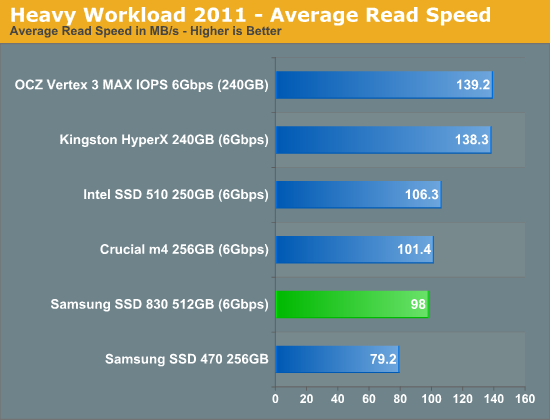
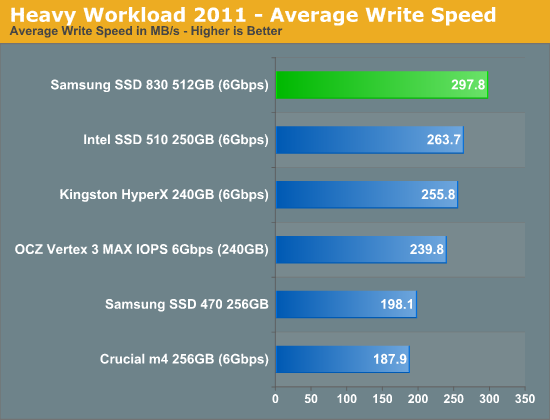
The SSD 830 actually does the best out of all of these drives when it comes to pure write speed. This isn't too surprising given how well the 830 performed in our incompressible sequential write test.
The next three charts just represent the same data, but in a different manner. Instead of looking at average data rate, we're looking at how long the disk was busy for during this entire test. Note that disk busy time excludes any and all idles, this is just how long the SSD was busy doing something:
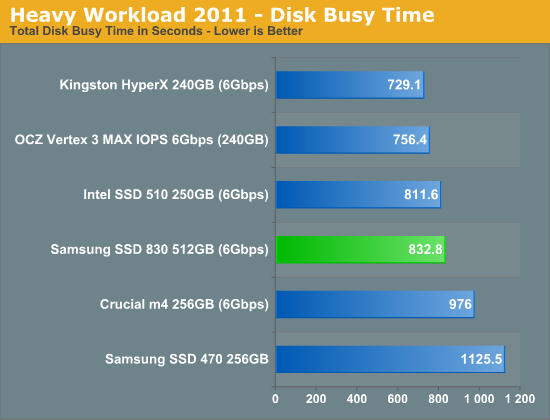
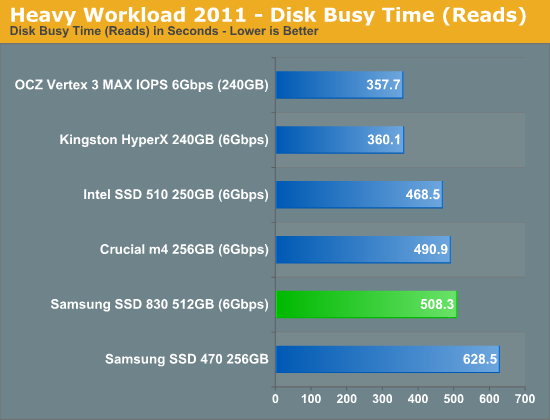
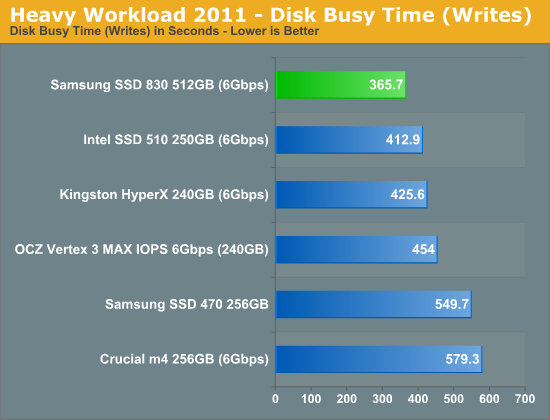










99 Comments
View All Comments
spudit88 - Saturday, September 24, 2011 - link
Great review- I've installed several of the 470 Series and they have been very reliable. I don't believe we have had issues with any of them. These are mostly going into corporate laptops, so the fastest SSD's are not always the best option. I've stuck mainly with Samsung or Intel for reliability reasons. We are just now starting to deploy more laptops with 6Gb/s interfaces, it's good to know there are more choices out there....particularly with a larger drive option of 512GB.know of fence - Saturday, September 24, 2011 - link
The Sizes of these drives are multiples of 2, (64,128), does this imply that GB means the same as GB inside Windows, Gibibyte a.k.a 2^30 Byte or 1.073*10^9 Byte. Same as with RAM.Or does "GB" refering to SSD Sizes actually mean something completely different than MB (per second) in Speed Benchmarks.
know of fence - Saturday, September 24, 2011 - link
Sorry, It's all explained. Still a bummer, though.buzznut - Saturday, September 24, 2011 - link
Two years ago, Samsung seemed convinced the way of the future was hybrid drives that combined the best of both worlds-the capacity of a mechanical with the performance of an SSD. They had a lot of reliability problems with these drives, I expect that's why there aren't more of these drives on the market.What I am wondering is has Samsung completely abandoned this idea? What about other manufacturers? Do you think that the cost of producing such drives makes it impractical?
Some of the average performing SSDs have come down to the $1/GB price point, which is seemingly the magic number for those folks still hanging on desperately to their mechanical drives. Now I hear these same folks complaining about reliability being the main issue keeping them from adopting new technology, and they aren't wrong.
I haven't had any issues with my SSDs, I find them to be extremely reliable and now I don't think I could go back for a system drive. Initially I had an X25 40GB, now a 128GB Vertex III. So the reliability of the Samsung drives is refreshing news and I sincerely hope the drives will be priced competitively because I'd really like to see them succeed with this.
I still think, if implemented properly, that there is a market for hybrid drives. Don't know that anyone is willing to risk that though.
Evonick - Saturday, September 24, 2011 - link
I'm curious if anyone knows the actual time involved for idle time garbage collection, and whether that process is equivalent to TRIM? Anand mentions "overnight" in the review, but does itgc really take 8 hours? And when does it start? After 3 minutes of idle or 3 hours? And when the itgc is completed, how does the drive perform compared to a TRIMmed drive?FunBunny2 - Saturday, September 24, 2011 - link
-- I've been working on an enterprise workload suite to figure that out...In order for this to be "real", encrypted data input is required. The reason is that relational databases in Enterprise are increasingly configured with encryption.
tpi2007 - Saturday, September 24, 2011 - link
I Anand, congratulations for the review and the video review, both of which I enjoyed very much.I was looking at the power consumption figures and was wondering if Samsung's higher numbers could have to do with their use of DDR2 for cache ? And by that I mean two things:
1. The fact that it's much bigger than Intel's for example should add to the power consumption, adding to the fact that they store user data, which probably means more data being written and read from all the time, increasing power consumption;
2. The fact that it's DDR2. Is it low power DDR2 or just normal 1.8v DDR2 ? That could explain the higher power consumption to a certain extent too. What if Samsung were to use low power 1.35 or even better, 1.25v DDR3L ?
Best regards,
tpi2007
FunBunny2 - Saturday, September 24, 2011 - link
Along similar lines: why is there not a power loss test in the suite? There appears to be no superCap on the board, yet the part uses "massive" amounts of DRAM with user data. This looks like a bleeding Achille's heel.enigma80 - Saturday, September 24, 2011 - link
This worried me too. 256MB of user data in a limbo?It would be importante to test a power loss amid writing to the drive and check the data on the drive.
Obsoleet - Thursday, January 19, 2012 - link
Excellent points. I'd like to hear an answer to this.The more I read, the more I feel Intel is the way to go.. even vs this Samsung and M4s.